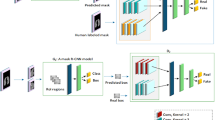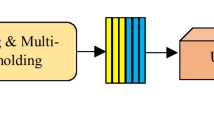Abstract
In a conventional Computer-Aided Detection (CAD) system, complexity is seen in the classification procedure of Lung Nodule Detection (LND). Lower classification accuracy along with a high False-Positive Rate (FPR)is caused since the classification outcome extremely relies on the performance of every step in LND. The work proposed a new Deep Learning (DL) approach for detecting and classifying Lung Nodules (LNs) from Computer Tomography (CT) images to address these difficulties. Initially, the input lung image is pre-processed, and then the non-informatics blocks are removed using Step Deviation Mean Multilevel Thresholding (SDMMT). After that, the lung image’s contrast is enriched and the earliest event-Net classifier is utilized to detect the LN parts. From the identified LN portion, the features are retrieved and the important features are chosen using an optimization algorithm called Minkowski Distance-based Horse herd optimization Algorithm (MD-HHOA). The selected features are fed into the Crossover Swap-Displacement and Reversion-based Jaya-Weight Hinge Generative Adversarial Network (CSDR-J-WHGAN) classifier for classifying as nodule or non-nodule. This study utilizes publicly accessible Lung Image Database Consortium image collection (LIDC-IDRI) datasets.The experiential result shows that the proposed method attains 97.11% accuracy, 96.98% sensitivity, and 94.34% specificity for detecting nodules when compared with the existing methods.









Similar content being viewed by others
Data availability
Data sharing is not applicable to this article as no datasets were generated or analyzed during the current study.
References
Ali Z, AunIrtaza MM (2021) An efficient U-net framework for lung nodule detection using densely connected dilated convolutions. J Supercomput 78(1):1602–1623. https://doi.org/10.1007/s11227-021-03845-x
Bhatia S, Sinha Y, Goel L (2019) Lung Cancer Detection: A Deep Learning Approach. In: Lung cancer detection a deeplearning approach, 1st edn. Springer, Singapore. https://doi.org/10.1007/978-981-13-1595-4_55
Chlap P, Min H, Vandenberg N, Dowling J, Holloway L, Haworth A (2021) A review of medical image data augmentation techniques for deep learning applications. J Med Imaging Radiat Oncol 65(5):545–563. https://doi.org/10.1111/1754-9485.13261
Dongdong G, Liu G, Xue Z (2021) On the performance of lung nodule detection, segmentation and classification. Comput Med Imaging Graph 89:1–15. https://doi.org/10.1016/j.compmedimag.2021.101886
Fan L, Xia Z, Zhang X, Feng X (2017) Lung nodule detection based on 3D convolutionalneural networks. International conference on the Frontiers and advances in data science 23–25 Oct 2017, Xi’an, China. https://doi.org/10.1109/FADS.2017.8253184
Fang T (2018) A novel computer-aided lung cancer detection method based on transfer learning from googlenet and median intensity projections. IEEE international conference on computer and communication engineering technology 18–20 august 2018, Beijing, China. https://doi.org/10.1109/CCET.2018.8542189
Feng B et al (2020) Solitary solid pulmonary nodules a CT-based deep learning nomogram helps differentiate tuberculosis granulomasfrom lung adenocarcinomas. Eur Radiol 30(12):6497–6507. https://doi.org/10.1007/s00330-020-07024-z
Gong L, Jiang S, Yang Z, Zhang G, Wang L (2019) Automated pulmonary nodule detection in CT images using 3D deep squeeze and excitation networks. Int J Comput Assist Radiol Surg 14(11):1969–1979. https://doi.org/10.1007/s11548-019-01979-1
Gupta V, Mittal M, Mittal V, Saxena NK (2021) A critical review of feature extraction techniques for ECG signal analysis. J Inst Eng (India): Series B 102:1049–1060. https://doi.org/10.1007/s40031-021-00606-5
Halder A, Dey D, Sadhu AK (2020) Lung nodule detection from feature engineering to deeplearning in thoracic CT images a comprehensive review. J Digit Imaging 33(3):655–677. https://doi.org/10.1007/s10278-020-00320-6
Heurtier AH (2019) Texture feature extraction methods a survey. IEEE Access 7:8975–9000. https://doi.org/10.1109/ACCESS.2018.2890743
Kowsari Y, Chabok SJM, Moattar MH (2020) Classification of pulmonary images by using generative adversarial networks. 4th conference on swarm intelligence and evolutionary computation 2–4 September 2020, Mashhad, Iran. https://doi.org/10.1109/CFIS49607.2020.9238755
Kuo C-FJ, Huang C-C, Siao J-J, Chia-Wen Hsieh V, Huy Q, Ko K-H, Hsu H-H (2020) Automatic lung nodule detection system using image processing techniques in computed tomography. Biomed Signal Process Control 56:1–20. https://doi.org/10.1016/j.bspc.2019.101659
Li Y, Fan Y (2020) DeepSEED: 3D squeeze-and-excitation encoder-decoder convolutional neural networks for pulmonary nodule detection. 2020 IEEE 17th International Symposium on Biomedical Imaging (ISBI), Iowa City, pp 1866–1869. https://doi.org/10.1109/ISBI45749.2020.9098317
Liang CH, Liu YC, Wu MT, Garcia-Castro F, Alberich-Bayarri A, Wu FZ (2019) Identifying pulmonary nodules or masses onchest radiography using deep learning external validation and strategies to improve clinical practice. Clin Radiol 75(1):38–45. https://doi.org/10.1016/j.crad.2019.08.005
Mehta K, Jain A, Mangalagiri J, Menon S, Nguyen P, Chapman DR (2021) Lung nodule classification using biomarkers, volumetric radiomics, and 3D CNNs. J Digit Imaging 34:647–666. https://doi.org/10.1007/s10278-020-00417-y
Naeimi FM, Azizyan G, Rashki M (2021) Horse herd optimization algorithm a nature-inspired algorithm for high-dimensional optimization problems. Knowl-Based Syst 213:1–17. https://doi.org/10.1016/j.knosys.2020.106711
Naqi SM, Sharif M, Jaffar A (2018) Lung nodule detection and classification based on geometric fit in parametric form and deep learning. Neural Comput & Applic 32(10):4629–4647. https://doi.org/10.1007/s00521-018-3773-x
Naqi SM, Sharif M, Lali IU (2019) A 3D nodule candidate detection method supported by hybrid features to reduce false positives in lung nodule detection. Multimed Tools Appl 78(12):26287–26311. https://doi.org/10.1007/s11042-019-07819-3
Nasrullah N, Sang J, Alam MS, Mateen M, Cai B, Haibo H (2019) Automated lung nodule detection and classification using deep learning combined with multiple strategies. Sens 19(17):1–19. https://doi.org/10.3390/s19173722
Ren Y, Tsai M-Y, Chen L, Wang J, Li S, Liu Y, Jiam X, Shen C (2019) A manifold learning regularization approach to enhance 3D CTimage-based lung nodule classification. Int J Comput Assist Radiol Surg 15(2):287–295. https://doi.org/10.1007/s11548-019-02097-8
Schultheiss M, Schober SA, Lodde M, Bodden J, Aichele J, Muller-Leisse C, Renger B, Pfeiffer FPD (2020) A robust convolutional neural network for lung nodule detection in the presence of foreign bodies. Sci Rep 10(1):1–9. https://doi.org/10.1038/s41598-020-69789-z
Singh S, Mittal N, Singh H (2020) A multilevel thresholding algorithm using LebTLBO for image segmentation. Neural Comput & Applic 32(3):166810–116706. https://doi.org/10.1007/s00521-020-04989-2
Sreekumar A, Nair KR, Sudheer S, Ganesh Nayar H, Nair JJ (2020) Malignant lung nodule detection using deep learning. International Conference on Communication and Signal Processing 28–30 July 2020, India. https://doi.org/10.1109/ICCSP48568.2020.9182258
TalhaMeraj, Arslan Hassan, SalihaZahoor, Hafiz Tayyab Rauf, IkramUllahLali M, liaqat Ali, Syed Ahmad Chan Bukhari (2021) Lungs nodule detection using semantic segmentation and classification with optimal features. Neural Comput & Applic 33(17):10737–10750. https://doi.org/10.1007/s00521-020-04870-2
Tiwari L, Raja R, Awasthi V, Miri R, Sinha GR, Alkinani MH, Polatf K (2021) Detection of lung nodule and cancer using novel Mask-3 FCM and TWEDLNN algorithms. Measurement 172(5):1–14. https://doi.org/10.1016/j.measurement.2020.108882
Ullah I, Kuri SK (2020) Lung nodule detection and classification using deep neural network. IEEE Region 10 Symposium 5–7 June 2020, Dhaka, Bangladesh. https://doi.org/10.1109/TENSYMP50017.2020.9230793
Wang W, Chakraborty G (2019) Evaluation of malignancy of lung nodules from CT image using recurrent neural network. IEEE international conference on systems, man and cybernetics 6–9 October 2019, Bari, Italy. https://doi.org/10.1109/SMC.2019.8913885
Acknowledgements
We thank the anonymous referees for their useful suggestions.
Author information
Authors and Affiliations
Contributions
All authors contributed to the study conception and design. Material preparation, data collection and analysis were performed by Vijay Kumar Gugulothu, Dr.SavadamBalaji. The first draft of the manuscript was written by Vijay Kumar Gugulothu.
and all authors commented on previous versions of the manuscript.All authors read and approved the final manuscript.
Corresponding author
Ethics declarations
Conflict of interest
The authors declare that they have no conflict of interest.
Ethical approval
This article does not contain any studies with human participants or animals performed by any of the authors.
Consent of publication
Not applicable.
Competing interests
The authors declare that they have no competing interests.
Additional information
Publisher’s note
Springer Nature remains neutral with regard to jurisdictional claims in published maps and institutional affiliations.
Rights and permissions
Springer Nature or its licensor (e.g. a society or other partner) holds exclusive rights to this article under a publishing agreement with the author(s) or other rightsholder(s); author self-archiving of the accepted manuscript version of this article is solely governed by the terms of such publishing agreement and applicable law.
About this article
Cite this article
Gugulothu, V.K., Balaji, S. A novel deep learning approach for the detection and classification of lung nodules from CT images. Multimed Tools Appl 82, 47611–47634 (2023). https://doi.org/10.1007/s11042-023-15416-8
Received:
Revised:
Accepted:
Published:
Issue Date:
DOI: https://doi.org/10.1007/s11042-023-15416-8




